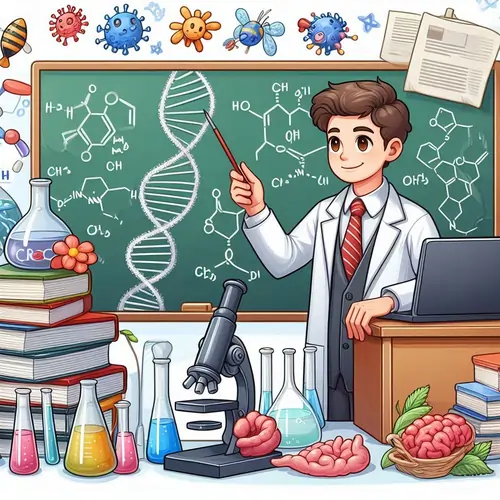Understanding Genetic Code, Transcription, and Translation in Molecular Biology

Molecular biology is a complex and fascinating field, and understanding its key concepts is crucial for university students tackling biology assignment related to mRNA, genetic codes, transcription, and translation. This guide aims to provide detailed explanations and insights to help you master these concepts and excel in your studies.
Understanding the intricate processes of molecular biology is crucial for university students tackling assignments in this field. This blog provides detailed explanations and insights to help you grasp essential concepts related to mRNA, genetic codes, transcription, and translation. By delving into these topics, you'll gain a deeper comprehension of the mechanisms that govern cellular functions.
The Genetic Code and Codons
The genetic code is characterized by its degeneracy, meaning that multiple codons can specify the same amino acid. For instance, the AUC and AUA codons in mRNA both specify isoleucine. This redundancy allows for certain mutations to occur without altering the amino acid sequence of proteins, providing a level of protection against genetic variations.

When considering the number of nucleotides in mRNA codons, it's essential to remember that each codon consists of three nucleotides. Thus, 12 codons would comprise 36 nucleotides. This triplet nature of the genetic code ensures that the information required to produce proteins is efficiently and accurately encoded.
Transcription Specificity and Promoter Regions
In prokaryotic organisms like E. coli, the sigma (σ) subunit of the RNA polymerase enzyme confers specificity to transcription. This subunit recognizes and binds to specific promoter regions on the DNA structure, initiating the transcription process. Prokaryotic promoters contain consensus sequences at the -10 and -35 regions, which are similar across different bacterial species. These sequences play a crucial role in the binding of RNA polymerase and the subsequent initiation of transcription.
Promoter Features and Transcription Inhibition
Both prokaryotic and eukaryotic promoters share certain features, such as the TATA box. This conserved DNA sequence is essential for the initiation of transcription in many genes. Additionally, transcription can be affected by various inhibitors. For example, low levels of α-amanitin specifically inhibit RNA polymerase II, which synthesizes pre-mRNAs in eukaryotic cells.
Pre-mRNA Processing and Stability
Pre-mRNA processing involves several critical steps that ensure the stability and functionality of the resulting mRNA. The addition of a 7-methylguanosine cap to the 5' end of pre-mRNA is crucial for initiating translation, as it facilitates the binding of ribosomes. Methylation and other nucleotide modifications enhance the stability of pre-tRNAs and pre-rRNAs, protecting them from enzymatic degradation.
Ribosome Synthesis and tRNA Synthetases
The RNA components of ribosomes are synthesized in the nucleolus, a specialized region within the nucleus. Ribosomal RNA (rRNA) is then assembled into ribosomal subunits, which are essential for protein synthesis. Each species has at least 20 different types of aminoacyl tRNA synthetases, one for each of the 20 amino acids used in protein synthesis. These enzymes play a critical role in charging tRNAs with their respective amino acids, ensuring accurate translation.
Critical Thinking in Molecular Biology
Exploring hypothetical scenarios can deepen your understanding of molecular biology. For instance, imagine if there were 200 commonly occurring amino acids instead of 20. The shortest possible codon length would need to be four nucleotides to accommodate the increased number of amino acids, given that a three-nucleotide codon would not provide enough combinations.
The degeneracy of the genetic code makes cells more robust to mutations. Because multiple codons can specify the same amino acid, certain mutations do not alter the protein product. This redundancy helps protect organisms from the potentially harmful effects of genetic variations.
When considering the relationship between mRNA and DNA strands, it's important to note that mRNA is complementary to the DNA template strand and similar, but not identical, to the DNA nontemplate strand. This difference arises because RNA contains uracil (U) instead of thymine (T).
Transcription Termination and Protein Function
Transcription termination in prokaryotes can occur through rho-dependent or rho-independent mechanisms. Rho-dependent termination involves the rho protein, which binds to mRNA and moves along it until it reaches RNA polymerase, causing the polymerase to dissociate from the DNA. Rho-independent termination relies on the formation of a hairpin structure in the mRNA followed by a sequence of uracils, which destabilizes the RNA-DNA hybrid and leads to the release of the RNA transcript.
Transcribing and translating a DNA sequence can illustrate these concepts in action. For example, the DNA sequence 5'-ATGGCCGGTTATTAAGCA-3' (nontemplate strand) would be transcribed into the mRNA sequence 5'-AUGGCCGGUUAUUAAGCA-3' and then translated into the protein sequence Met-Ala-Gly-Tyr-(Stop), with UAA as a stop codon.
Single nucleotide changes, or point mutations, can have vastly different effects on protein function. A silent mutation does not change the amino acid sequence, while a missense mutation results in a different amino acid, which may or may not affect protein function. A nonsense mutation creates a premature stop codon, often leading to a truncated and nonfunctional protein.
Conclusion
By understanding these fundamental concepts and exploring detailed explanations, university students can better grasp the intricacies of molecular biology. This knowledge not only aids in answering genetics assignment questions but also lays the foundation for more advanced studies in genetics and cellular biology. Keep exploring, questioning, and seeking a deeper understanding to excel in your academic journey.